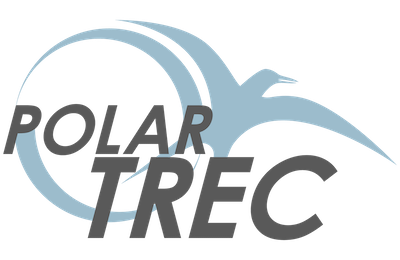Teacher/Researcher Collaborations
The PolarTREC program and my experience with NASA’s Operation IceBridge during the 2016 Spring Arctic Campaign in Greenland has reinforced my belief in teacher-researcher collaborations as a powerful tool for engaging students in STEM and giving them the chance to think and explore career possibilities outside of the four walls of their classrooms. One of the most effective ways to engage students in the classroom is to leverage the power of human connection, stories that allow students to feel connected to otherwise “far-off” research they may only encounter in textbooks or online. Teachers should have the opportunity to go on science expeditions, because it allows them to act as a link between students in the classroom and real innovative research. 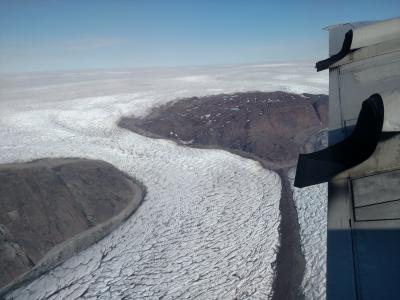
To provide some background about my project before delving into its impact on my students, my community, and my own perspective it is important to know that Operation IceBridge is a complex machine built of many moving parts, instrument teams, program managers, sea and land ice scientists, flight crew, logistics coordinators, outreach personnel and requires fluid communication with weather centers, flight control towers, and members of the communities out of which science flights are based. Operation IceBridge is the largest airborne survey of Earth’s polar ice and has been collecting data on ice thickness and extent since 2009. Its name stems from its role in maintaining a continuous record of data after the ICESat satellite malfunctioned. It is bridging any potential gaps in data collection before ICESat 2 is ready for launch in 2018.
Expectations and Outcomes
Upon returning from my PolarTREC experience in Greenland, I was very aware that every single day I was in the field at some point, I commented or wrote about how “surreal” the experience was. Each day was more exciting and beautiful and impactful than the last and my heart and soul were full as I experienced the true and pure beauty of our Earth and became a part of a crew who was capturing that beauty and the important information hidden within to build a continuous record of our changing planet. This experience was transformational not only as a classroom teacher, but as an individual and steward of our Earth and on a truly personal level.
Before heading out into the field I created a list of areas of growth. I expected to gain a greater understanding of the instruments used on board an Operation IceBridge aircraft and hoped to develop lessons for my students to introduce them to remote sensing. In order to engage students of all background and ability levels, I was hoping to create an adaptable simulation using Vernier Labquest sensors and I will describe the lesson developed from this experience in the classroom implementation section on outreach. 
One piece of technical information that I feel helped my students and I understand the airborne science process better is the function of satellite GPS data and a ground station. A video of the ground station located in Thule, Greenland during the Spring 2016 Arctic Campaign is located below.
The Power of Collaboration
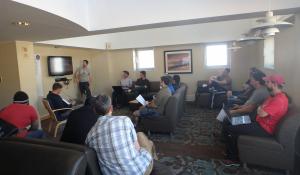
Redesign and Flexibility
Some days you are “socked in” (that is, your flight plan is barricaded by fog that will interfere with optical instruments and prevent smooth flight operations); some days you are in the middle of a 100% success rate of data collection (which means for the entire mission, nothing interfered with data collection including cloud cover, etc.)
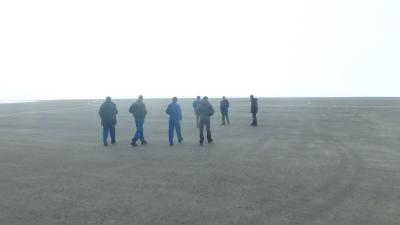
I vividly remember one of the first flights I was able to participate in involved a glitch in communication between one of the monitors on board and another instrument. In order for our flight to collect accurate data that needed to be fixed before takeoff. Additionally in order to get back to base in time, the window for takeoff was very specific. This was a perfect example of many experts working together to troubleshoot and solve a problem. Flight engineers from NOAA, experts from Kansas State University, and NASA’s Airborne Topographic Mapper engineers worked quickly together to find a solution that worked. This was a clear example of members of different agencies who did not know each other prior to the mission working together toward a common goal. To these scientists and flight crew members, it is all part of the job, but for my students that story was an important motivator for their own team-based projects and assignments.
Engineering vs Science
I feel that this experience also provided me with an excellent example to share with students about the relationship between each of the disciplines in S.T.E.M. For example, the Airborne Topographic Mapper (ATM) team builds all of their own instruments. 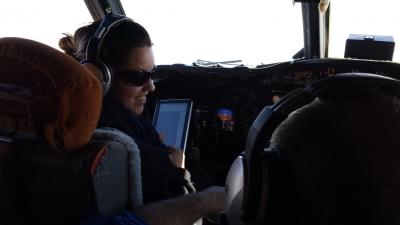
Student Outreach
Prior to leaving for the expedition I spent time with each grade level from pre-K through 12th grade in my school to share information about Operation IceBridge and to allow them to create flags or tokens to go to Greenland. 
I was able to link this experience directly back to my classroom in several ways including preparing a lab for 8th grade students in which they simulated an airborne remote sensing campaign over a hidden topography using Vernier sensors. 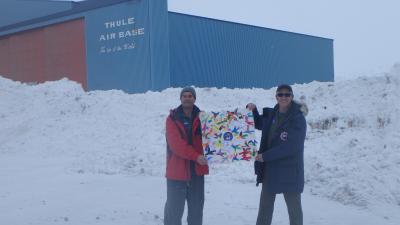
Another way I hope to use this in my classroom in the future is to work with students to work more with the data sets accumulated through NASA Operation IceBridge campaigns. 11th and 12th grade students in my classroom have learned how to access data sets temporally and by specific variables measured in the NSIDC web portal for Operation IceBridge missions, and I hope to facilitate practice in constructing models with that data. 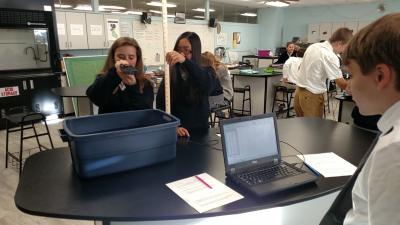
Google’s MyMaps application is an example of a GIS tool that students can use to create an overlay of the data extracted from NSIDC (collected by Nasa’s Operation IceBridge). Along with the mapping tools used in virtual communications with students from Operation IceBridge via Mission Tools Suite for Education.
Professional Outreach and Teacher to Teacher Collaboration
Along with bringing the experience of PolarTREC and NASA’s Operation IceBridge back to my classroom and students, I have found several venues through which to share the experience with colleagues around the globe. Through virtual interactions using Edmodo and interactions within the PolarTREC journals, I have been able to connect with classrooms and educators across the U.S., in South Africa, the Philippines, and Germany. I have also presented the work to colleagues at our annual Diocesan Conference, co-presented with another PolarTREC NASA Operation IceBridge teacher at NSTA, and provided several community talks. 
I have also been able to develop ideas for lesson plans and curricular materials further by participating in collaborative teacher events such as a Google Hackathon on GEO-education. That experience allowed me to share my PolarTREC experience and ideas-in-development with educators and scientists and received great feedback to further develop projects that use GIS application within them.
We’ll Figure this Out
One of the greatest and most impactful takeaways for my classroom from my PolarTREC experience was the raw, unsolicited advice from scientists, engineers, pilots, visualization experts, an astronaut, and an incredible program manager. The enthusiasm about reaching the next generation of innovators through my experience was tangible and exciting. Often researchers or engineers on board would mention that having a platform to educate students about their work reminds them of its importance and removes any (if there could possibly be!) routine feeling about their work. 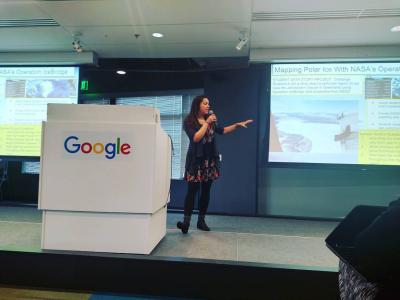
Along with the researchers, flight crew and engineers on board the Operation IceBridge project, I had the opportunity to encounter many inspiring individuals throughout the expedition, in particular one individual who made an impact beyond belief. That person was the late Dr. Piers Sellers, who along with sharing as much science content as he could with myself, he shared some of his most important advice for students. Number one was “Don’t be afraid of the hard stuff. Take physics and calculus and work through the challenges that might exist on your first try. Make mistakes, it’s okay. But take them early.” He referenced his past educators with high admiration and really valued the importance of education. Sometimes an experience allows you to meet someone who will make you rethink the problems in our world and reignite your passion for learning. Each of my students know Dr. Sellers’ name and his story. 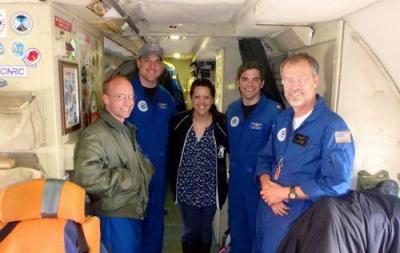
Looking Toward the Future
I hope to continue to work toward educating my community members and students about the importance of polar science education. I would like to leverage the experience to build polar science curriculum, combining the experience with an upcoming trip to Antarctica. Additionally, I plan to stay in contact with fellow PolarTREC teachers, setting up visits and staying in touch with OIB scientists and NOAA flight crew to construct future outreach events. I hope to collaborate with my fellow Operation IceBridge PolarTREC teachers to propose joint talks at various conferences, especially as we continue to develop our lesson plans and curricular materials further.

| Attachment | Size |
|---|---|
| Download Report (1.27 MB)1.27 MB | 1.27 MB |
This program is supported by the National Science Foundation. Any opinions, findings, and conclusions or recommendations expressed by this program are those of the PIs and coordinating team, and do not necessarily reflect the views of the National Science Foundation.
